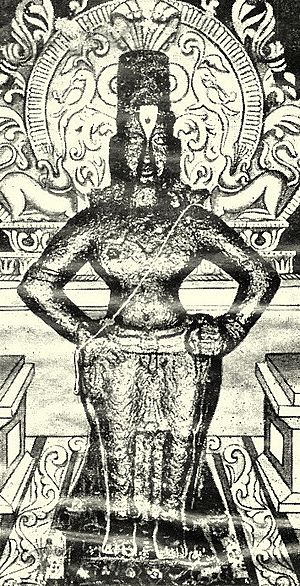Vithoba facts for kids
Vithoba is a Hindu god worshipped mainly in the Indian states of Maharashtra and Karnataka. He is also known as Vitthala and Panduranga. He is generally considered a form of the Hindu god Vishnu or Krishna. In stone images and pictures, he is shown as a dark young boy. He stands on a brick with his hands on his waist. His wife Rukmini or Rakhumai stands with him.
Vithoba's main temple is at Pandharpur in Maharashtra. It is close to its border with Karnataka. Two Hindu sects, the Varkari sect of Maharashtra and Haridasa sect of Karnataka worship Vithoba as their main god. The Varkari poet-saints have written devotional poems called abhangas in praise of god Vithoba. The abhangas are written in the language Marathi. The Haridasa poets have also written poems, devoted to Vithoba in the Kannada language. The two most important festivals associated with Vithoba are Shayani Ekadashi in the Hindu month of Ashadha, and Prabodini Ekadashi in the Hindu month of Kartik.
Images for kids
-
Vithoba (left, 4th from top) replaces Buddha in a depiction of the Dashavatar—ten avatars (of Vishnu)—on the door of Sree Balaji Temple, Goa.
-
A Varkari journeys from Alandi to Pandharpur. He carries a veena (lute) with saffron flag attached, and cymbals tied to strings in his hands.
-
The Vitthala temple in Hampi, Karnataka, was built by Krishnadevaraya, whose guru Vyasatirtha was a key Haridasa figure.
-
A four-armed Vithoba, a 19th-century painting from Tiruchchirappalli, Tamil Nadu. Here, Vithoba is depicted as an arms-akimbo Vishnu.
-
The chief gate of Vithoba's Pandharpur temple. The first step of the temple is regarded as saint Namdev's memorial and the small blue temple in front of the gate is saint Chokhamela's memorial.
See also
 In Spanish: Vithoba para niños
In Spanish: Vithoba para niños















